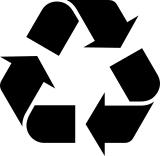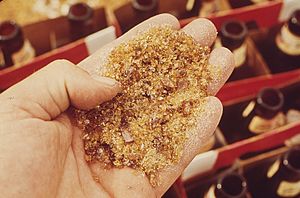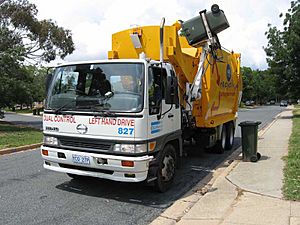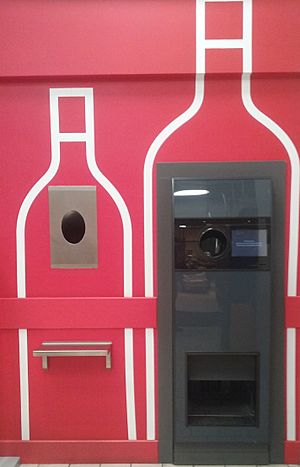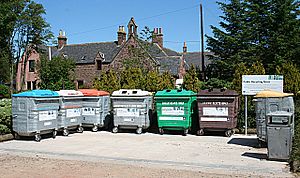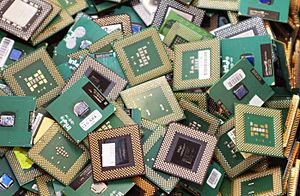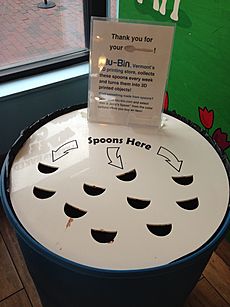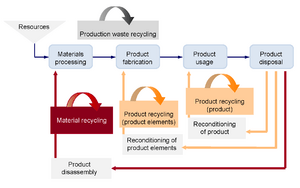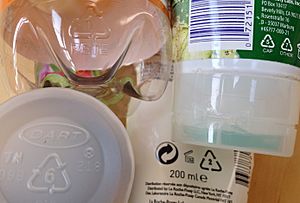Recycling facts for kids
Recycling is a special process that takes old, used materials and turns them into brand new things. Think of it like giving trash a second chance to become something useful again. It's a key part of taking care of our planet.
When we recycle, we prevent potentially useful materials from being wasted. We also reduce the need to dig up or harvest new raw materials from the Earth, which saves energy and reduces pollution in the air and water. Recycling is often called the third step in the important "Reduce, Reuse, and Recycle" idea, which helps us protect the environment and use our resources wisely.
Many different things can be recycled, including glass, paper, cardboard, metals, plastics, old tires, textiles (like clothes), batteries, and electronics. Even food scraps and garden waste can be recycled through composting, which turns them into rich soil.
Materials for recycling are usually collected from our homes in special bins or taken to recycling centers. Then, they are sorted, cleaned, and processed so they can be used to make new items. Ideally, recycling a material means it can become the same type of material again – like old paper becoming new paper. Some materials, like metal cans, can be recycled over and over without losing their quality. Other materials might be turned into something different – like plastic bottles becoming fibers for clothing.
Contents
History
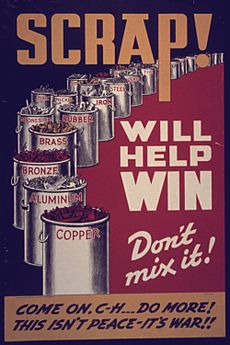

People have been reusing materials for a very long time. Even ancient civilizations understood the value of not wasting things, especially when resources were hard to find. When archaeologists study old waste sites, they find less household trash during times when resources were scarce, suggesting people were reusing and recycling more out of necessity.
In older times, before big factories, people would collect scrap metal to melt down and use again. Paper recycling was happening in Japan as early as the year 1031! In Britain, people called "dustmen" would collect ash and dust from fires to use in making bricks. These early forms of recycling were often done because it was cheaper to use recycled materials than new ones, and it helped deal with waste in towns that were getting bigger.
As industries grew, so did the need for materials. Scrap metals became very valuable. Railroads and early car companies bought lots of scrap metal. People would even search through trash to find discarded metal items to sell.
Around the 1800s, some companies, like those making drinks, started offering money back if you returned their bottles. Sweden set up an official system for this in 1884 for bottles and later for aluminum cans, which helped them recycle a lot of their containers.
Recycling During Wartime
During big wars, like World War II, recycling became super important for governments. Money and materials were limited, so reusing and recycling goods was necessary. Countries ran huge campaigns asking citizens to save metal, paper, cloth, and rubber as a patriotic duty to help the war effort. This showed how recycling could help a whole country make the most of its resources.
Recycling After the Wars
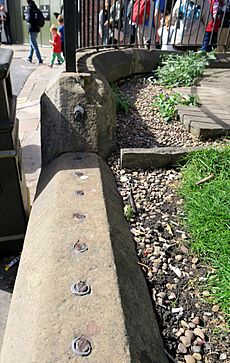
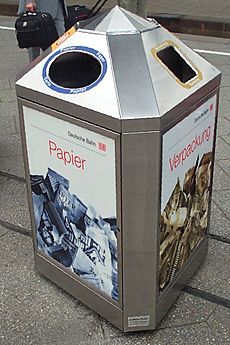
After World War II, especially in the 1970s when energy costs went up, people realized that recycling could save a lot of energy. For example, recycling aluminum uses only a tiny amount of the energy needed to make new aluminum from scratch. Recycling glass, paper, and other metals also saves significant energy.
Recycling old electronics, or "e-waste," started becoming a bigger deal in the 1990s. Switzerland was one of the first countries to start collecting old refrigerators and other devices. As more and more electronics were made and thrown away, dealing with e-waste became a challenge because it contains valuable materials but also some harmful ones. This led to new rules and better ways to recycle electronics safely.
In recent years, countries around the world have set goals to recycle more. For example, the European Union has aimed for countries to recycle at least half of their waste. By 2015, the United Nations set global goals, including one to significantly reduce waste by 2030 by increasing recycling rates.
Around 2018, there were some big changes in the global recycling market. Some countries that used to buy a lot of recycled materials from other places started setting stricter rules about what they would accept. This caused some challenges for recycling programs in many countries, making people think more about how recycling is done and where materials go after they are collected. This has encouraged countries to find ways to process more materials closer to home.
How Recycling Works: From Your Bin to New Products
Getting materials from your home or a business to a place where they can be turned into new things involves a few steps.
Collection
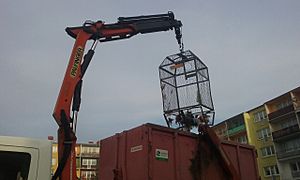
There are different ways recycling is collected:
- Curbside Collection: This is when recycling trucks pick up materials right from bins or bags outside your home. This is convenient for people but requires special trucks and sorting later. Sometimes, all recyclables are mixed together (commingled or single-stream), and sometimes you separate them yourself (source separation). Single-stream is easier for you, but sorting facilities need advanced machines to separate everything correctly. Source separation gives cleaner materials but means more bins and collection trips.
- Drop-off Centers: These are places where you take your sorted recyclables yourself. They are easier for cities to set up but depend on people making the effort to bring their materials.
- Buy-back Centers: At these places, you can sell certain recyclables, like aluminum cans, for a small amount of money. This gives people a direct reason to recycle and helps create a steady supply of materials.
- Distributed Recycling: For some materials, like plastic, new technologies are allowing people to recycle locally, sometimes even turning waste plastic into materials for 3D printers right in their community. This can save on transportation costs and energy.
Collecting recyclables is often the most expensive part of the whole recycling process.
Sorting
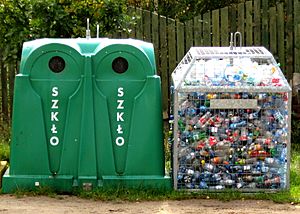
Once the mixed recyclables arrive at a special facility called a Materials Recovery Facility (MRF), they need to be sorted.
First, the materials are spread out on conveyor belts. People or machines might pull out large items that could jam the equipment, like plastic bags or big pieces of cardboard. Then, machines use different methods to separate materials. Screens might shake things to separate smaller items from larger ones. Air blowers can lift lighter materials like paper and plastic away from heavier things like glass and metal. Magnets are used to pull out metals that contain iron, like steel and tin cans. Other machines use special magnetic forces (called eddy currents) to push away non-magnetic metals like aluminum cans. Optical scanners can use light to identify different types of plastic and paper based on what they are made of. This is important because different types of plastic need to be recycled separately. Glass is often sorted by color (clear, brown, green) because different colors are used to make different new glass products. Modern sorting facilities use amazing technology, including robots and computer systems, to sort materials quickly and accurately. However, it's still important for people to try and put the right things in the recycling bin and keep them clean, because contamination (like food waste on paper) can make materials harder to recycle properly.
Plastic recycling
Recycling plastic is a bit more complex because there are many different types of plastic.
- Physical Recycling: This is the most common type. It involves melting down waste plastic and shaping it into new plastic objects. For example, plastic bottles can be melted and turned into fibers for clothing or carpets. However, plastic can sometimes lose some of its quality each time it's melted and reshaped, meaning it can only be recycled a few times before it's no longer usable for certain products.
- Chemical Recycling: This is a newer method that breaks down plastic using chemicals to turn it back into its basic building blocks. These building blocks can then be used to make new, high-quality plastic that is just like the original. This method can potentially recycle plastics that are harder to recycle physically.
- Waste Plastic to Fuel: Some processes can even turn mixed plastics into fuel oil using heat. This isn't quite recycling into new plastic, but it does turn waste into something useful.
Industrial Recycling
Recycling isn't just for homes! Industries produce a lot of waste too, and they recycle materials like cardboard, metal, glass, and paper.
- Metal Recycling: Metals are great because they can often be recycled over and over again without losing quality. Scrap metal from old cars, buildings, and factories is melted down to make new metal products. Even valuable metals like gold and silver can be recovered from old electronics.
- Construction Recycling: When old buildings or roads are taken down, materials like concrete and asphalt can be crushed and used to build new roads or structures.
- E-waste Recycling: Recycling electronics is important because they contain valuable metals and other materials, but also some substances that can be harmful if not handled correctly. Special facilities carefully take apart electronics to recover materials like copper, aluminum, and precious metals. It's crucial that e-waste is recycled responsibly to protect the environment and the health of workers.
Recycling Codes
Have you ever seen numbers inside a little triangle of arrows on plastic items? These are recycling codes! They were created to help recyclers identify what type of plastic a product is made from.
In the United States, plastics are usually marked with numbers 1 through 7:
- 1 (PET): Common in soda and water bottles.
- 2 (HDPE): Used for milk jugs, detergent bottles, and some containers.
- 3 (PVC): Found in some bottles, pipes, and other items.
- 4 (LDPE): Used for plastic bags, squeezable bottles, and some films.
- 5 (PP): Found in yogurt containers, straws, and some food containers.
- 6 (PS): Used for foam cups, egg cartons, and disposable plates.
- 7 (Other): This includes all other types of plastic or mixtures of plastics.
Just because a plastic has a code doesn't always mean your local recycling program accepts it. Numbers 1 and 2 are the most commonly recycled plastics. The codes help sorting facilities know how to process the materials correctly.
Why Recycle?
Recycling has many great benefits for our planet and even for people!
Environmental Benefits
- Saves Natural Resources: Recycling means we don't have to take as many raw materials from the Earth, like cutting down trees for paper or mining for metals.
- Saves Energy: Making products from recycled materials almost always uses less energy than making them from scratch. For example, recycling aluminum saves a huge amount of energy!
- Reduces Pollution: Recycling reduces the need for activities like mining and manufacturing from raw materials, which can cause air and water pollution. It also reduces pollution from landfills and incinerators (which burn trash).
- Reduces Greenhouse Gas Emissions: Because recycling saves energy and reduces the need for energy-intensive processes, it helps lower the amount of greenhouse gases released into the atmosphere, which is good for fighting climate change.
- Creates Jobs: The recycling industry creates many jobs, from collecting and sorting materials to processing them and making new products.
- Can Save Money for Cities: While setting up recycling programs costs money, they can save cities money in the long run by reducing the amount of waste sent to landfills, which can be expensive.
- Creates a Market for Materials: Recycling creates a demand for used materials, giving them value instead of just being thrown away.
Challenges
Recycling isn't always easy, and there are some challenges:
- If recyclables are mixed with trash or food waste, they can become contaminated and harder to recycle into high-quality new products.
- Some materials are tricky to sort, especially when they are mixed together.
- Sometimes, even if materials are collected and sorted, it can be hard to find companies that want to buy and use them to make new products.
- In some cases, especially for certain materials or in certain areas, the cost of collecting and processing recyclables can be higher than sending waste to a landfill. However, this often doesn't include the environmental costs of landfills or making new materials.
- Many products aren't designed in a way that makes them easy to take apart and recycle at the end of their life.
Getting Involved
Recycling works best when everyone helps out! Our actions at home make a big difference. Putting the right things in the recycling bin and keeping them clean helps the whole process run smoothly.
Studies have shown that when people see their friends and neighbors recycling, they are more likely to do it too! Schools often have recycling programs and clubs to teach students about its importance and encourage good habits.
While some materials like metals have very high recycling rates, others, especially certain types of plastic, are recycled much less often. Getting more people involved and making recycling easier are key to increasing these rates.
Recycling in the Future
Looking ahead, the goal is to move towards something called a "circular economy." This idea is about keeping materials in use for as long as possible, rather than using them once and throwing them away. It's like a circle where materials are reused, repaired, and recycled over and over.
Advanced technologies, like smart sorting machines and robots, are helping to make recycling more efficient and able to handle more types of materials. Community efforts, like teaching people about recycling and making it convenient, are also super important. By working together and using new technologies, we can reduce waste, save resources, and create a healthier planet for everyone.
Related pages
Images for kids
-
Some people in Brazil earn their living by collecting and sorting garbage and selling them for recycling.
See also
 In Spanish: Reciclaje para niños
In Spanish: Reciclaje para niños


